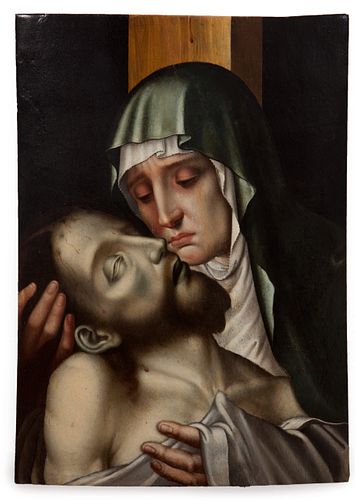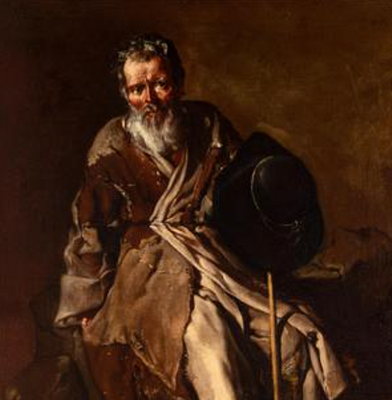LUIS DE MORALES (Badajoz, ca. 1510-1586). "Mercy." Oil on panel.
Lot 70
About Seller
Setdart Auction House
Carrer Aragó 346
Barcelona
Spain
Setdart Subastas was born in 2004 and is currently the first online art auction in Spain with solidity, prestige and reliability guaranteed by our more than 60,000 users. Setdart has a young, dynamic and enterprising team ready to successfully manage the purchase and sale of art works through custom...Read more
Estimate:
EUR€12,000 - EUR€15,000
$12,903.23 - $16,129.03
Absentee vs Live bid
Two ways to bid:
- Leave a max absentee bid and the platform will bid on your behalf up to your maximum bid during the live auction.
- Bid live during the auction and your bids will be submitted real-time to the auctioneer.
Bid Increments
| Price | Bid Increment |
|---|---|
| EUR€0 | EUR€10 |
| EUR€200 | EUR€25 |
| EUR€500 | EUR€50 |
| EUR€1,000 | EUR€100 |
| EUR€3,000 | EUR€200 |
| EUR€5,000 | EUR€500 |
| EUR€10,000 | EUR€1,000 |
| EUR€20,000 | EUR€2,000 |
| EUR€50,000 | EUR€5,000 |
About Auction
By Setdart Auction House
Jun 1, 2021
Set Reminder
2021-06-01 09:45:00
2021-06-01 09:45:00
America/New_York
Bidsquare
Bidsquare : OLD MASTERS & SCULPTURE - Day 2
https://www.bidsquare.com/auctions/setdart-auction-house/old-masters-sculpture---day-2-6999
Setdart Auction House sofia@setdart.com
Setdart Auction House sofia@setdart.com
- Lot Description
LUIS DE MORALES (Badajoz, ca. 1510-1586). "Mercy." Oil on panel. Measurements: 39 x 28 cm This work shows us the theme of the Pietà. In it we can see the Virgin resting her head on her son, while holding him from behind. The use of cold and muted tones added to the type of composition, placing the Cross in the background, then the Virgin and finally, in the foreground, the figure of the Dead Christ. The iconography of the Pietà arises from a gradual evolution of five centuries and, according to Panofsky, derives from the theme of the Byzantine Threnos, the lamentation of the Virgin over the dead body of Jesus, as well as from the Virgin of Humility. The first artists to see the possibilities of this theme were German sculptors, the first example being found in the city of Coburg, a piece from around 1320. With the passage of time the iconography will spread throughout Europe, and already in the seventeenth century, after the Counter-Reformation, became one of the most important themes of devotional painting. A painter of great quality and marked personality, perhaps the best among the Spaniards of the second half of the 16th century, with the exception of El Greco. His training poses serious problems, although Palomino makes him a disciple of the Flemish painter Pedro de Campaña, who lived in Seville between 1537 and 1563. Certainly the meticulousness and detail of his brushwork and the conception of the landscape are of Flemish origin, and most of his iconic themes of late medieval tradition. But he makes some human types and uses a coloring and a sfumato related to the Lombard tradition of a Bernardino Luini and a Cristoforo Solario, which he surely knew not through a trip to Italy but possibly to Valencia, to catch up with the novelties contributed by the Leonardesque Fernando Yáñez and Fernando de Llanos and the Raphaelesque Vicente and Juan Masip. However, the most personal bias of his painting lies in the tormented and almost hysterical atmosphere in which his characters breathe, turned more than to action towards an intense inner life, full of melancholy and ascetic renunciation and characteristic of the climate of tense religiosity that the reform movements had imposed in 16th century Spain, from the less orthodox Erasmianism and Alumbradism, to the most genuine mysticism and Trentism. Morales, called the Divine by his first biographer, Antonio Palomino, because he painted only religious subjects with great delicacy and subtlety, reached his best period from 1550 to 1570, painting then numerous altarpieces, triptychs and isolated canvases that obtained enormous diffusion because they satisfied the popular religiosity of the time, although some of his canvases contain quotes and data of learned erudition, product of the contact with the enlightened clients, to count first of all the bishops of the diocese of Badajoz, in whose service he was. On the other hand, his presence in the monastery of El Escorial, called by Philip II, is not documented, although it seems that the latter acquired some of his works to give them as gifts. The enormous production and the continuous request for his most frequent and popular iconographic themes forced him to maintain a large workshop in which his two sons, Cristóbal and Jerónimo, collaborated; a workshop responsible for many copies that circulate and are still considered to be Morales' autographs.
- Shipping Info
-
In-house shipping available. Please inquire at admin@setdart.com.
-
- Buyer's Premium



 EUR
EUR CAD
CAD AUD
AUD GBP
GBP MXN
MXN HKD
HKD CNY
CNY MYR
MYR SEK
SEK SGD
SGD CHF
CHF THB
THB















